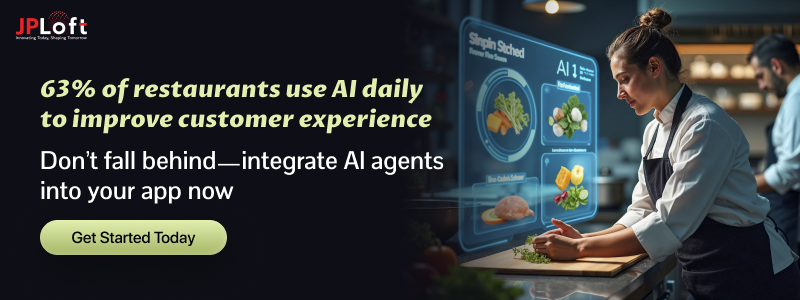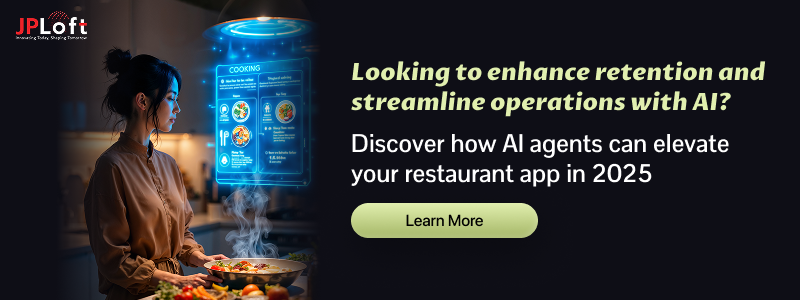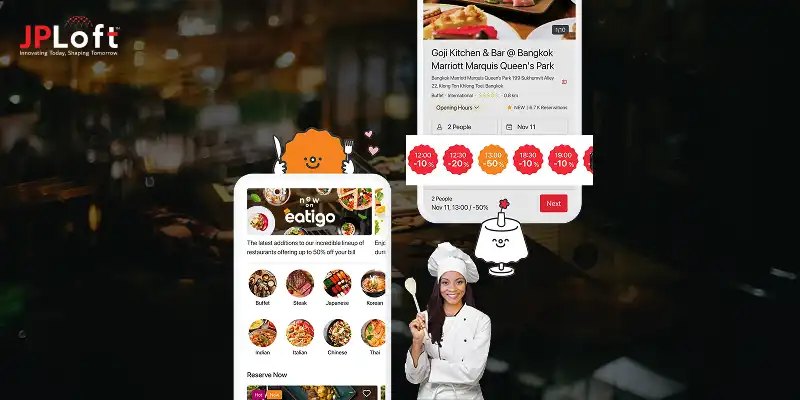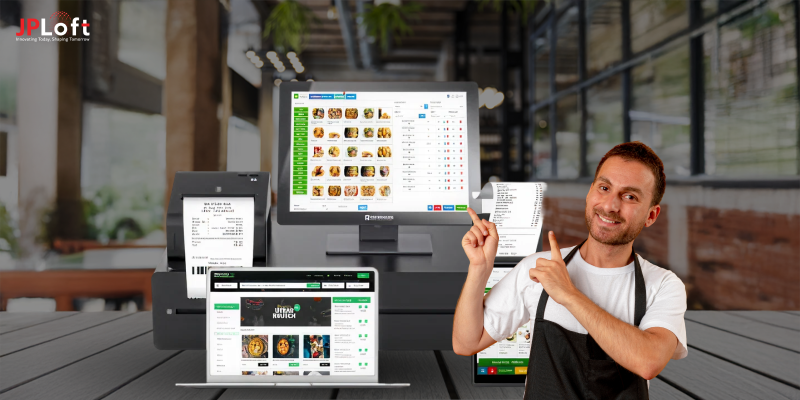Why Are AI Agents Reshaping the Future of Restaurant Apps?
"AI is not just about efficiency, it’s about creating experiences that feel personal, intuitive, and almost human." – TechCrunch
As a restaurant owner or as an entrepreneur, you know the challenges customers face, endless scrolling through menus, difficulties in customizing orders, and frustration when support is slow.
“Imagine your restaurant app with an AI assistant that learns preferences, anticipates choices, and suggests meals that result in boosting satisfaction, sales, and loyalty.”
That’s exactly the role of AI agents in restaurant apps, making dining smarter, faster, and far more personalized.
As restaurants compete in a crowded digital world, AI agents are stepping in as the quiet revolution.
They don’t just process orders; they reshape the entire customer experience, bridging the gap between convenience and hospitality.
And in this blog, we’ll uncover how these AI agents are transforming restaurant apps today and what’s coming next.
Key Takeaways:
AI agents are revolutionizing restaurant apps with smarter, faster, and more personalized dining experiences.
The role of AI agents in restaurant apps includes voice ordering, predictive suggestions, and intelligent reservations.
Implementation requires overcoming challenges like development cost, data privacy, and continuous maintenance.
Future AI agent trends focus on hyper-personalization, predictive analytics, and AR/VR integration.
JPLoft, a trusted AI development partner, helps restaurants build innovative, scalable AI-driven solutions tailored to business needs.
Overview of AI: From Smart Machines to Smarter Dining
Artificial Intelligence (AI) is often seen as futuristic, but in reality, it’s already part of our daily lives.
From the way Google Maps predicts traffic to how Spotify suggests your next playlist, AI is quietly working behind the scenes.
At its core, AI is about teaching machines to think, learn, and adapt just like humans, only faster.
In the restaurant industry, AI isn’t just about efficiency; it’s about elevating the customer experience.
Imagine an app that remembers your go-to order, suggests dishes based on your mood, or even predicts when you’re most likely to reorder.
This is the power of AI in restaurant apps, where smart systems bring personalization to the forefront of dining.
For restaurants, leveraging AI is no longer optional. It’s becoming a necessity for staying ahead in the digital-first food economy.
From predictive analytics to AI-powered voice ordering, these intelligent systems are shaping restaurant app development trends that define the future of how customers interact with restaurants.
Why Restaurant Apps Require an AI Agent to Stay Ahead?
When it comes to modern dining, user expectations are higher than ever. Here’s why restaurant apps require an AI agent to meet those demands and outpace competitors:
1. Personalized Dining Experiences
Today’s customers don’t just want to order food; they want it tailored to their tastes.
What AI agents for restaurants do best is analyze user data to suggest meals, upsell combos, and even remember past preferences. This boosts satisfaction and drives repeat business.
2. Faster and Smarter Ordering
An AI agent can guide customers through the app, answer FAQs instantly, and provide real-time recommendations.
This makes the ordering process smoother while highlighting the benefits of AI agents in restaurant apps: speed, convenience, and accuracy.
3. Reducing Operational Burden
Restaurant owners often juggle staffing, customer queries, and order management.
AI agents help automate these tasks, freeing staff for high-value service.
With insights from restaurant app development challenges, it’s clear that AI integration is the smartest way forward.
4. Staying Competitive in a Digital-First Market
The food-tech industry is evolving rapidly. From loyalty programs to voice ordering, AI-driven apps are setting new standards.
Exploring top restaurant app features with AI agents ensures your app doesn’t just survive but thrives.
5. Boosting Revenue Opportunities
AI agents don’t just streamline service; they drive upselling and cross-selling.
By predicting what customers are most likely to order next, they answer the big question: how restaurant apps make money in today’s crowded space.
The Role of AI Agents in Restaurant Apps: What They Really Do?
AI agents aren’t just background tools; they’re active digital assistants transforming the way restaurant apps function.
Here’s a closer look at the role of AI agents in restaurant apps and how they’re redefining customer experiences:
► Personalized Recommendations
One of the most recognized use cases of AI agents in restaurant apps is personalization.
By analyzing a user’s order history, browsing behavior, and even time of day, AI agents can suggest tailored dishes, combos, or promotions.
This not only improves customer satisfaction but also drives repeat orders.
► Seamless Order Assistance
AI agents act like virtual waiters inside your app. They help customers navigate menus, answer common questions, and resolve queries instantly.
This implementation of AI agents for restaurant apps ensures faster ordering, fewer errors, and a more engaging interaction mimicking the feel of in-restaurant service.
► Smart Upselling and Cross-Selling
Think of AI agents as intuitive sales boosters. They recommend side dishes, beverages, or dessert pairings based on what the customer is ordering.
In competitive food markets, this strategy significantly increases average order value, demonstrating the benefits of AI agents in restaurant apps for both customers and businesses.
► Real-Time Customer Engagement
AI agents don’t just sit quietly; they engage actively. Whether it’s sending reminders about favorite meals, offering loyalty points, or suggesting seasonal offers, these smart assistants keep customers coming back.
Insights from restaurant app ideas show that engagement-driven features are a must-have for success.
► Voice Ordering Support
With the rise of conversational AI, AI voice ordering in restaurant apps has become a breakthrough.
Customers can place orders hands-free using natural speech, making the experience faster and more convenient, especially valuable for busy or on-the-go users.
► Data-Driven Insights for Owners
AI agents aren’t just customer-facing; they also empower restaurant owners.
By studying user behavior, order frequency, and preferences, AI agents provide actionable insights that shape marketing campaigns, menu design, and customer loyalty strategies.
This is why creating an AI agent for restaurant apps is becoming a critical step for long-term growth.
► Enhanced Customer Support
Finally, AI agents reduce reliance on human staff by handling routine queries such as delivery tracking, refund policies, and menu clarifications.
By automating repetitive tasks, they improve service efficiency while freeing staff to focus on higher-value customer interactions.
AI Agents in Restaurant Apps vs. Other Types of AI: What’s Unique?
Artificial Intelligence isn’t new; chatbots, recommendation engines, and predictive models already power many industries.
But AI agents in restaurant apps are different. They’re designed with a deeper focus on hospitality, personalization, and real-time decision-making.
Here’s how they stand apart from other types of AI:
1] Task-Specific Design
While general AI tools can serve multiple industries, AI agents in restaurants are built to address very specific challenges like food ordering, table reservations, or personalized menu curation.
This makes them far more specialized compared to generic AI app development services used elsewhere.
2] Personalized Dining Intelligence
Unlike standard AI recommendation systems, restaurant AI agents track meal preferences, dietary restrictions, and ordering habits.
They don’t just suggest “popular items”; they craft a personalized dining journey, reflecting the benefits of AI agents in restaurant apps.
3] Real-Time Customer Interaction
General AI often works passively in the background, but restaurant AI agents are highly interactive.
They answer questions, recommend add-ons, and even support voice-based orders. This makes them closer to digital waitstaff than static tools, aligning with insights from the restaurant app design guide.
4] Integration with Restaurant Ecosystems
Other AI models may only function on a single platform. In contrast, AI agents integrate seamlessly with POS systems, loyalty programs, delivery platforms, and even marketing tools.
This implementation of AI agents for restaurant apps ensures a smooth customer experience while simplifying operations for owners.
5] Revenue-Driven Functionality
Unlike broad AI applications that focus solely on automation, restaurant AI agents are profit-focused.
They boost upselling, reduce wait times, and optimize customer retention. Several of the best restaurant apps, which are highly successful, have already begun using AI agents to maximize these revenue opportunities.
Restaurant AI Agents vs. Traditional Restaurant Apps: What’s the Difference?
At first glance, a regular restaurant app and one powered by AI agents might look similar.
But dig deeper, and you’ll see major differences in how they operate and the value they deliver.
Here are the key differences between restaurant AI agents and traditional restaurant apps:
1. Static Menus vs. Dynamic Recommendations
Traditional restaurant apps display static menus with little personalization. In contrast, AI agents adapt menus based on preferences, dietary needs, and previous orders.
Hence, AI agents are the future of restaurant apps, helping the users to find effective ways to identify what’s best to order as per their mood, and preferences.
2. Manual Navigation vs. Guided Experiences
Older apps leave customers to search through endless options. With AI agents, users enjoy guided recommendations and instant answers to questions.
This evolution is closely tied to how to build an AI agent, which focuses on creating interactive, conversational experiences inside restaurant apps.
3. Basic Ordering vs. Intelligent Assistance
Traditional apps allow customers to place orders, but they stop there. AI-powered apps act as digital waiters, suggesting upsells, managing queries, and offering order tracking.
These capabilities are what define the role of AI agents in restaurant apps today.
4. Limited Insights vs. Data-Driven Decisions
Standard apps provide basic analytics. AI agents, however, track user behavior, peak times, and order preferences to give owners actionable insights.
This difference is especially important for brands exploring the cost to create an AI agent as part of their digital strategy.
5. One-Size-Fits-All vs. Personalized Journeys
Traditional apps treat every user the same. Restaurant AI agents learn, adapt, and create a custom dining experience, boosting both customer satisfaction and loyalty in the long run.
Comparison Table: Restaurant AI Agents vs. Traditional Restaurant Apps
|
Feature / Capability |
Traditional Restaurant Apps |
Restaurant AI Agents in Apps |
|
Menu Experience |
Static menus, no personalization |
Dynamic menus tailored to preferences |
|
User Navigation |
Manual browsing |
AI-guided experiences, conversational flow |
|
Order Processing |
Basic ordering only |
Intelligent assistance + upselling |
|
Data & Insights |
Limited analytics |
Data-driven insights & predictions |
|
Customer Experience |
One-size-fits-all |
Personalized journeys with learning AI |
|
Engagement Level |
Low interaction |
High engagement via real-time adaptation |
How to Build an AI Agent in Restaurant Apps?
Building an AI agent for a restaurant app demands both technical accuracy and product empathy.
Below is an expanded, practical guide that walks you through goals, architecture, data, testing, launch, and scaling, with each step broken into clear substeps.
Step 1: Define Clear Objectives
Identify the key challenges your restaurant app aims to solve and align AI capabilities with business goals to ensure measurable impact on customer experience and operational efficiency.
A] Understand Customer Pain Points
Map common friction: confusing menus, long booking wait-times, repetitive support requests, or poor personalization.
Framing these pain points helps clarify the role of AI agents in restaurant apps; that is, solving real customer problems rather than building tech for tech’s sake.
B] Align with Business Goals
Connect AI capabilities to business outcomes (higher table turn, increased average order value, lower support costs).
If you’re also launching or scaling, link the AI roadmap to how to start an online restaurant business goals so the technology directly supports revenue and growth.
C] Define Measurable KPIs
Set tangible metrics (e.g., reduce support tickets by 40%, increase repeat orders by 15%).
These SMART KPIs keep development focused and make it clear later whether the benefits of AI agents in restaurant apps are being realized.
Step 2: Design the AI Agent Architecture
Outline the structure of your AI agent, including data flow, decision-making logic, and integration points with your restaurant app to ensure smooth and efficient performance.
A] Natural Language & Intent Layer
Build an NLP/intent pipeline so the agent understands varied customer phrasing (menu questions, substitutions, dietary restrictions).
That conversational core defines how AI agents in restaurant apps feel human and helpful rather than robotic.
B] Data Integration & Syncing
The agent must read live menus, inventory, POS, and reservation data to avoid errors.
This integration is a key part of the implementation of AI agents for restaurant apps; it’s what keeps responses accurate and operational workflows smooth.
C]Scalability & Fault-Tolerance
Architect for traffic bursts (lunch/dinner peaks) and graceful degradation (fallback to human support).
A well-designed backend ensures the agent remains responsive even under stress, which is essential if you’re thinking about how to develop a restaurant app that scales regionally.
Step 3: Choose the Right Technology Stack
Select the appropriate programming languages, AI frameworks, and cloud services to ensure your AI agent is robust, scalable, and seamlessly integrates with your restaurant app.
A] AI / ML Frameworks & Tools
Pick frameworks that match your team’s skills and goals (e.g., transformer-based NLP for complex conversational needs; simpler intent-classifiers for basic Q&A).
Choosing correctly speeds up time-to-market as you develop restaurant AI agents with confidence.
B] Cloud & DevOps Choices
Leverage managed services for hosting, autoscaling, and monitoring.
A containerized approach and CI/CD pipelines let you push updates safely, which is critical when you maintain a live service across many users.
C] Security, Privacy & Compliance
Build data handling with privacy-first design: encryption at rest/in transit, tokenization for payments, and compliance checks.
These safeguards protect guest data and reduce liability while you create an AI agent for restaurant apps.
Step 4: Train the AI Agent with Real Data
Feed the AI agent with authentic customer and operational data to enhance its learning, accuracy, and ability to provide personalized recommendations and efficient responses.
A] Customer Interaction & Conversation Logs
Use anonymized chat logs, call transcripts, and support tickets to teach the agent actual customer language.
Real examples reduce misunderstandings and make the AI far more useful in production.
B] Menu, Availability & Business Rules
Feed the agent detailed menu taxonomy, modifiers, and inventory rules so it can suggest substitutions or block unavailable items.
This keeps the customer experience smooth and reduces failed orders.
C] Continuous Learning Loop
Establish feedback loops: let agents flag low-confidence answers and route them to human agents for correction, then retrain the model on those corrections.
This iterative training is where creating an AI agent for restaurant apps moves from templated to genuinely smart.
Step 5: Build, Test, and Refine
Develop the AI agent’s features, run thorough tests across scenarios, and fine-tune its algorithms to ensure reliability and optimal performance in real-world conditions.
A] Prototype & Progressive Rollout
Launch a minimal viable agent that handles a few high-value tasks (reservations, common FAQs, simple recommendations).
Prototypes reveal UX issues quickly and reduce risk before scaling to full capabilities like upsell logic.
B] Cross-Platform & Edge Case Testing
Test across iOS, Android, web, and different locales. Validate payment flows, time-zone logic, allergy queries, and concurrency.
Follow a reliable guide to maintain a restaurant app to ensure proper post-launch support, proven best practices, and regular regression testing.
C] A/B Testing & Performance Monitoring
Run experiments (e.g., two recommendation strategies) and instrument metrics, response accuracy, time-to-resolution, revenue per session.
Continuous A/B testing lets you refine things that matter to customers and the business.
Step 6: Launch, Monitor, and Operate
Deploy the AI agent within your app, continuously monitor its performance, gather user feedback, and make necessary adjustments. To maintain effectiveness and customer satisfaction.
A] Pilot, Feedback & Human-in-the-Loop
Start with a pilot cohort, gather qualitative feedback, and keep a human fallback available.
Early human oversight both protects brand experience and provides training data to improve the agent.
B] Operational Metrics & Alerts
Monitor conversion funnels, failed intents, and user satisfaction.
Clear alerting lets you act on issues fast and understand how AI agents are transforming restaurant apps operationally.
C] Maintain Health to Avoid Failure
Regular audits prevent drift and stale recommendations. This is where many teams learn why restaurant apps fail after initial success.
Scheduling maintenance windows, retraining cadence, and rollback plans protects long-term adoption.
Step 7: Scale Features & Business Integration
Expand the AI agent’s capabilities by adding new features and deeper integrations with restaurant operations, enhancing both user experience and business efficiency over time.
A] Add Booking & Reservation Depth
Evolve the agent to handle complex bookings, multi-table support, deposit logic, waitlists.
B] Expand Revenue Features: Upsell, Promotions, Loyalty
Introduce context-aware offers (e.g., recommend desserts to users who ordered certain mains) to lift average order value while preserving relevance and trust.
C] Business Growth & Ecosystem Integration
As you add branches, third-party delivery, or new menus, ensure the AI’s data model scales.
Successful scaling demonstrates how to integrate AI while still running a profitable restaurant operation.
Breaking Down the Cost to Create an AI Agent for Your Restaurant App
When restaurants think of AI, one of the first questions is cost. Integrating an AI agent in a restaurant app can range from $15,000 for basic solutions to $80,000+ for advanced, feature-rich implementations.
Investing in an AI agent isn’t just about adding technology; it’s about ensuring long-term ROI through smarter automation, personalized customer experiences, and operational efficiency.
Let’s explore the cost to integrate an AI agent in restaurant apps by breaking it into key factors.
1. Complexity of Features
The more advanced the AI capabilities, like voice ordering, predictive suggestions, and multilingual support, the higher the development cost.
Restaurants must carefully select features that align with their business goals to avoid overspending. This factor heavily impacts the cost to develop a restaurant app.
2. Technology Stack & Tools
The choice of AI frameworks, cloud platforms, and third-party APIs influences both upfront and ongoing costs.
Using cloud AI services like AWS or Google Cloud can reduce initial expenses, while custom-built frameworks require higher budgets.
This is an important consideration when calculating the cost to build a restaurant reservation app like OpenTable.
3. Data Preparation & Training
AI agents need clean, labeled datasets to function efficiently. Collecting menu data, customer preferences, and ordering patterns takes time and resources.
The scope of data preparation directly affects the cost to integrate an AI agent in restaurant apps.
4. Integration with Existing Systems
Seamless synchronization with POS systems, loyalty programs, and delivery platforms is crucial.
Complex integrations require extra development effort and testing, which can increase both time and resource requirements during app development.
5. Testing & Iteration
Thorough testing ensures the AI agent correctly understands customer queries and performs reliably.
Iteration cycles for debugging and optimizing AI behavior add to the total development cost, impacting the cost to create an AI agent for restaurant app.
6. Maintenance & Updates
AI agents evolve over time with changing menus, seasonal trends, and customer behavior.
Planning for updates and support is essential for long-term ROI and forms a key part of the steps to create an AI agent for restaurant apps.
Cost Breakdown Table
|
Component |
Basic Implementation |
Advanced Implementation |
Notes |
|
Feature Complexity |
$5,000 – $15,000 |
$20,000 – $40,000 |
More features = higher cost |
|
Technology Stack & Tools |
$3,000 – $7,000 |
$10,000 – $20,000 |
Cloud vs custom frameworks |
|
Data Preparation & Training |
$2,000 – $5,000 |
$8,000 – $15,000 |
Larger datasets increase cost |
|
System Integration |
$3,000 – $6,000 |
$10,000 – $18,000 |
POS, delivery, loyalty program connections |
|
Testing & Iteration |
$1,500 – $4,000 |
$5,000 – $10,000 |
Multiple testing cycles for reliability |
|
Maintenance & Updates (Annual) |
$1,000 – $3,000 |
$5,000 – $8,000 |
Ongoing support and updates |
|
Total Estimated Cost |
$15,500 – $40,000 |
$58,000 – $80,000+ |
Depending on feature set, data, and integrations |
Key Challenges in Adding AI Agents to Restaurant Apps
While the role of AI Agents in restaurant apps is reshaping customer experiences, integrating these systems isn’t without hurdles.
Restaurants must carefully plan the implementation of AI Agents for restaurant apps to avoid unnecessary costs and operational friction.
A] High Development Costs
The cost to integrate an AI Agent in restaurant apps can vary depending on the complexity of features like natural language processing, multilingual support, and predictive ordering.
Smaller restaurants often struggle with balancing budgets while still wanting advanced AI solutions.
B] Technical Complexity
Building AI-powered systems requires specialized expertise. Teams must manage data training, voice recognition, and cloud integration.
For businesses without in-house tech talent, it becomes essential to hire dedicated developers who understand both AI and restaurant workflows.
C] Data Privacy & Security
Since AI agents process customer preferences and payment details, ensuring compliance with GDPR and other regulations is critical. Any data breach can damage trust and reputation.
D] Maintenance & Scalability
AI systems need continuous upgrades to remain effective. Partnering with a reliable provider of mobile app maintenance services helps ensure the AI agent adapts to changing demands, seasonal traffic, and customer expectations.
E] Testing & Quality Assurance
Rigorous trials are required to make sure the AI agent works seamlessly across multiple devices and languages. Focusing on restaurant app testing helps brands identify and fix errors before launch.
Overcoming these challenges is crucial for those who want to develop restaurant AI agents that are cost-efficient, scalable, and customer-friendly.
Restaurants that address these obstacles head-on will be better positioned to unlock the true benefits of AI agents in restaurant apps.
Inspiring Use Cases of AI Agents in Restaurant Apps
The use cases of AI agents in restaurant apps prove that this technology is not just futuristic but already transforming the way customers order, interact, and experience dining.
Let’s explore some of the most impactful implementations:
1. Personalized Ordering and Recommendations
What AI agents for restaurants do best is analyze customer preferences to recommend meals, drinks, or combos.
This personalization increases satisfaction and boosts average order value. Many brands even create an AI app tailored to their unique customer data to maximize these benefits.
2. Voice Ordering for Convenience
One of the leading benefits of AI agents in restaurant apps is voice ordering.
Customers can simply speak their order, making the process faster and more inclusive for people with accessibility needs.
Innovators who want to create a mobile app with AI-powered voice capabilities are quickly gaining an edge.
3. Smart Reservation Systems
Restaurants use AI agents to handle reservations dynamically, managing cancellations, waitlists, and seating efficiency.
Businesses exploring how to build an app like TheFork often adopt these AI-driven reservation systems to enhance user convenience.
4. Operational Efficiency for Staff
AI agents streamline kitchen communication and reduce errors in orders.
This implementation of AI agents for restaurant apps cuts down staff workload while improving service speed.
Many restaurants partner with a mobile app development company UK to integrate such robust features effectively.
5. Feedback Collection & Sentiment Analysis
Another vital use case of AI agents in restaurant apps is gathering customer reviews in real time and analyzing them to spot improvement areas.
Businesses that aim to develop restaurant AI agents often include this feature to stay ahead of customer expectations.
These examples show exactly how AI agents are transforming restaurant apps, making them smarter, faster, and more customer-focused than ever.
AI Agent Trends Shaping Restaurant App Development
The future of dining technology lies in AI agents in restaurant apps, where innovations continue to redefine how customers interact with food services.
Below are the most significant AI agent trends shaping the industry.
► Hyper-Personalized Dining Experiences
The role of AI agents in restaurant apps is moving toward hyper-personalization, where customer tastes, diets, and habits drive meal suggestions.
Restaurants eager to make an AI agent in restaurant apps are focusing on tailoring menus to individual users.
► Predictive Ordering and Smart Suggestions
By analyzing order history, AI agents can suggest what customers might want before they even search.
This implementation of AI agents for restaurant apps enhances convenience and increases sales. Brands that explore top AI agent project ideas often use predictive systems as a foundation.
► Integration with AR and VR
Creating an AI agent for restaurant apps is no longer just about chatbots; it’s about immersive experiences.
Imagine previewing dishes in AR before ordering. Restaurants that adopt AI + AR integration are gaining strong market traction.
► AI-Powered Restaurant Operations
The steps to create an AI Agent for restaurant apps now include AI-powered staff scheduling, inventory tracking, and dynamic pricing.
Many forward-thinking brands partner with an AI agents vs agentic AI guide to understand the difference and choose the right approach.
► Autonomous Customer Service
In the future, customers will interact with AI agents that solve queries instantly, without human intervention.
Businesses aiming to build a restaurant AI agent see this as a way to boost efficiency while improving service quality.
These trends highlight how AI agents are transforming restaurant apps, making them smarter, more interactive, and business-ready for the next decade.
Talk to the Experts and Build an AI Agent for Your Restaurant Apps
Building advanced solutions like AI-driven ordering, smart recommendations, or predictive systems requires the right expertise.
At JPLoft, we specialize in developing intelligent restaurant apps tailored to modern dining needs.
Our team ensures smooth implementation of AI agents for restaurant apps, from planning to deployment, while keeping scalability and user experience at the core.
As a leading AI agent development company, we provide end-to-end support from designing custom features to ongoing maintenance so your restaurant can stay ahead of the competition.
Partner with the best Restaurant App Development Company to unlock the real benefits of AI agents in restaurant apps and deliver the seamless, tech-driven experiences your customers expect.
Conclusion
The role of AI agents in restaurant apps is no longer limited to automation; it’s about delivering smarter, faster, and more personalized dining experiences.
From voice-enabled ordering to predictive suggestions and intelligent reservations, the use cases of AI agents in restaurant apps continue to expand.
However, businesses must consider factors like scalability, data privacy, and cost before implementation.
By understanding the true benefits of AI agents in restaurant apps and aligning them with customer needs, restaurants can create lasting value.
As the industry evolves, those who develop restaurant AI agents today will lead tomorrow’s market with apps that not only serve food but also deliver exceptional digital experiences.
FAQs
The role of AI agents in restaurant apps is to automate tasks like voice ordering, personalized suggestions, and smart reservations, making dining faster and more engaging.
The benefits of AI agents in restaurant apps include improved efficiency, reduced staff workload, higher order accuracy, and personalized customer experiences.
To know how to build an AI agent for a restaurant app, you need to define features, set budgets, choose technology, and work with AI development experts.
What AI agents for restaurants do is simplify ordering, manage bookings, handle customer queries, and provide data-driven insights for better business decisions.
The cost to create an AI agent for a restaurant app depends on complexity, integrations, and features. It typically ranges from $15,000 to $50,000.
By offering predictive ordering, multilingual support, and real-time feedback, AI agents are transforming restaurant apps into intelligent digital assistants.













Share this blog